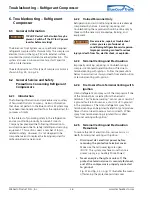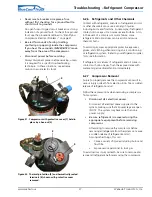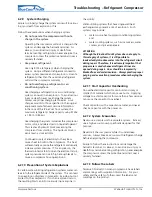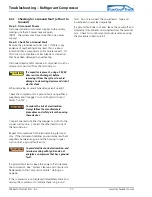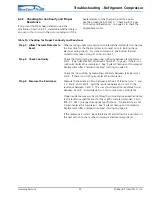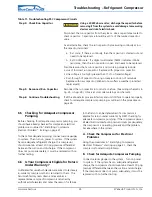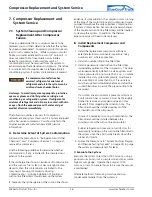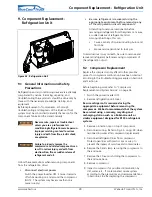
Troubleshooting – Refrigerant Compressor
Webasto Product N.A., Inc.
26
www.techwebasto.com
™
6. Troubleshooting – Refrigerant
Compressor
6.1
General Information
110 VAC Device! Lethal current may be
present. Switch off the DC to AC power
inverter before servicing!
The BlueCool Truck System uses a specifically designed
refrigerant compressor for this assembly. The compressor
electrical motor is the type, PSC with external surface
mounted thermal and current overload protection. This
system also uses a run capacitor and a start capacitor
with an internal relay.
The electrical system of this type of compressor motor is
shown in Fig. 34, on pg. 34.
6.2
General Service and Safety
Precautions Concerning Refrigerant
Compressors
6.2.1
Introduction
The following information and procedures are courtesy
of Tecumseh Products Company. Certain information
that does not pertain to the BlueCool Truck System may
have been intentionally omitted from the original text for
purposes of clarity.
In the interest of promoting safety in the refrigeration
and air conditioning industry, Tecumseh Products
Company has prepared the following information to
assist service personnel in safely installing and servicing
equipment. This section covers a number of topics
related to safety. However, it is not designed to be
comprehensive or to replace the training required for
professional service personnel.
6.2.2
Trained Personnel Only
Refrigeration and air conditioning devices are extremely
complicated by nature. Servicing, repairing, and
troubleshooting these products should be done only by
those with the necessary knowledge, training, and
equipment.
Never service, repair, or troubleshoot
unless you are a professional air
conditioning/refrigeration service person.
Improper servicing can lead to serious
injury or death from fire, electric shock, or explosion.
6.2.3
Terminal Venting and Electrocution
Improperly servicing, repairing, or troubleshooting a
compressor can lead to electrocution or fire due to
terminal venting with ignition. Follow the precautions
below to avoid serious injury or death from electrocution
or terminal venting with ignition.
6.2.4
Fire Hazard from Terminal Venting with
Ignition
Oil and refrigerant can spray out of the compressor if one
of the terminal pins is ejected from the hermetic
terminal. This “terminal venting” can occur as a result of
a ground fault (also known as a short circuit to ground)
in the compressor. The oil and refrigerant spray from
terminal venting can be ignited by electricity and produce
flames that can lead to serious burns or death. When
spray from terminal venting is ignited this is called
“terminal venting with ignition.”
6.2.5
Terminal Venting and Electrocution
Precautions
To reduce the risk of electrocution, serious burns, or
death from terminal venting with ignition:
•
Disconnect ALL electrical power before
removing the protective terminal cover.
Make sure that all power legs are open.
(NOTE: The system may have more than one
power supply, e.g. Auxiliary Shore Power.)
•
Never energize the system unless: 1) the
protective terminal cover is securely fastened,
and 2) the compressor is properly connected
to ground.
Fig. 31 and Fig. 32, on pg. 27 illustrates the means
of fastening the protective terminal cover.
WARNING
WARNING















